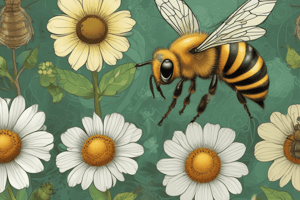Podcast
Questions and Answers
What is the average lifespan of a worker bee during the summer?
What is the average lifespan of a worker bee during the summer?
4-6 weeks
What is the purpose of a smoker in beekeeping?
What is the purpose of a smoker in beekeeping?
To calm bees by producing smoke, which interferes with their communication and reduces aggression.
How often should a queen bee be replaced?
How often should a queen bee be replaced?
Every 2-3 years
What is the process of reducing water content in honey production?
What is the process of reducing water content in honey production?
What is a common pest that can infest bee colonies?
What is a common pest that can infest bee colonies?
What is the purpose of regular hive inspections?
What is the purpose of regular hive inspections?
Flashcards are hidden until you start studying
Study Notes
Bee Biology
- A colony of bees consists of:
- One queen bee
- 10,000-60,000 worker bees (female)
- 1,000-2,000 drones (male)
- Worker bees:
- Live for 4-6 weeks during summer
- Perform different tasks based on age
- Communicate through pheromones and dance
- Queen bee:
- Lives for 2-3 years
- Lays 1,000-2,000 eggs per day
- Controls colony growth and reproduction
Beekeeping Equipment
- Protective clothing:
- Veil
- Gloves
- Beekeeping suit
- Hive components:
- Hive body
- Supers
- Frames
- Foundation
- Smoker:
- Used to calm bees by producing smoke
- Interferes with bee communication and reduces aggression
Hive Management
- Regular inspections:
- Check for signs of disease, pests, and queen issues
- Monitor honey production and brood development
- Hive maintenance:
- Clean and repair hive equipment
- Control pests and diseases
- Queen management:
- Monitor queen health and performance
- Replace queen every 2-3 years
Honey Production and Harvesting
- Honey production:
- Bees collect nectar and store it in honeycomb cells
- Water content is reduced through evaporation
- Honey is capped with wax to seal and preserve
- Honey harvesting:
- Extract honey from frames using a extractor
- Filter and bottle honey for consumption
Common Beekeeping Challenges
- Pests:
- Varroa mites
- Small hive beetles
- Wax moths
- Diseases:
- American foulbrood
- Nosema
- Other challenges:
- Colony collapse disorder
- Pesticide use and environmental factors
Bee Biology
- A colony of bees is comprised of a queen bee, 10,000-60,000 worker bees, and 1,000-2,000 drones.
- Worker bees live for 4-6 weeks during summer, perform different tasks based on age, and communicate through pheromones and dance.
- Queen bees live for 2-3 years, lay 1,000-2,000 eggs per day, and control colony growth and reproduction.
Beekeeping Equipment
- Essential protective clothing for beekeeping includes a veil, gloves, and a beekeeping suit.
- Hive components include the hive body, supers, frames, and foundation.
- Smokers are used to calm bees by producing smoke, which interferes with bee communication and reduces aggression.
Hive Management
- Regular inspections are crucial to check for signs of disease, pests, and queen issues, as well as monitor honey production and brood development.
- Hive maintenance involves cleaning and repairing hive equipment, controlling pests and diseases, and monitoring for queen health and performance.
- Queen management involves replacing the queen every 2-3 years to ensure colony health and productivity.
Honey Production and Harvesting
- Honey production involves bees collecting nectar, storing it in honeycomb cells, and reducing water content through evaporation.
- Honey is capped with wax to seal and preserve it, and is harvested by extracting it from frames using an extractor.
- Harvested honey is filtered and bottled for consumption.
Common Beekeeping Challenges
- Pests that threaten bee colonies include Varroa mites, small hive beetles, and wax moths.
- Diseases that affect bee colonies include American foulbrood and Nosema.
- Other challenges faced by beekeepers include colony collapse disorder, pesticide use, and environmental factors.
Studying That Suits You
Use AI to generate personalized quizzes and flashcards to suit your learning preferences.




